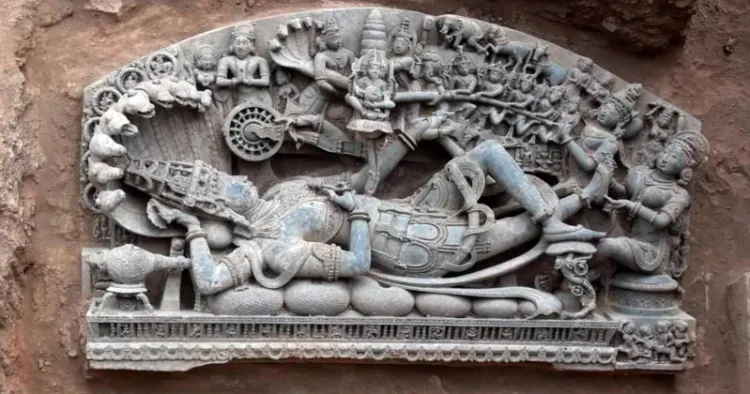An intricate and detailed ‘Sheshshayi Vishnu’ sculpture has been discovered by a team from the Archaeological Survey of India’s (ASI) Nagpur circle in Sindkhed Raja town, located in Maharashtra’s Buldhana district. This remarkable find was revealed during conservation work at Lakhuji Jadhavrao’s Chhatri, a site of historical significance.
The excavation occurred as part of the ongoing conservation efforts at Lakhuji Jadhavrao’s Chhatri, a site of historical significance. The ASI team, led by Superintendent Archaeologist Arun Malik, discovered a depth of 2.25 meters. Malik recounted the moment of discovery, noting that the team initially spotted some stone alignments, which prompted further digging. Their efforts eventually revealed the base of an ancient mandir.
“Upon exposing the sabha mandap (assembly hall), we decided to investigate the mandir’s depth,” Malik told media. “This led us to uncover a sculpture of goddess Laxmi. As we continued our excavation, we were astounded to find a magnificent Sheshshayi Vishnu sculpture in its entirety.”
The Sheshshayi Vishnu sculpture, measuring 1.70 meters in length and 1 meter in height, is a stunning representation of Vishnu reclining on Shesha Naga, with goddess Laxmi seated at his feet, massaging them. The sculpture is carved from chlorite schist rock, predominantly used in South Indian (Hoysala) art. Malik noted that the sculpture’s base, which is yet fully exposed, is estimated to be around 30 centimetres in width.
“This piece is exceptional due to its detailed carvings and the material used,” Malik explained. “The panel features intricate depictions of Dashavatara (the ten avatars of Vishnu) and the Samudramanthana (churning of the ocean), complete with jewels such as Ashwa (the divine horse) and Airavat (the elephant).”
The discovery is significant not only for its artistic value but also for its historical and cultural implications. Iconography expert Saili Palande-Datar highlighted the uniqueness of the sculpture’s material. “This schist stone is softer compared to the locally found basalt rock. Previous sculptures found in Marathwada were typically made from basalt. The donor couple, prominently carved between Sheshnaag and Samudramanthana, adds a distinctive touch to this panel,” she said.
Palande-Datar also emphasised the sculpture’s potential future importance. “When an art museum is eventually established in Maharashtra, this sculpture will undoubtedly be one of its masterpieces due to its intricate detail and unique material composition.”
The discovery began when the ASI team dug deeper beneath the mandir structure’s sabha mandap, originally discovered through conservation work at Lakhuji Jadhavrao’s Chhatri. The alignment of stones and the subsequent discovery of the mandir base provided the first clues to the presence of something significant. The find of the Laxmi sculpture served as a precursor to the unearthing of the much larger and detailed Sheshshayi Vishnu sculpture.
Further analysis reveals that the detailed panel of the sculpture showcases scenes from Sanatana Dharma, particularly the Samudramanthana, a well-known episode that illustrates the churning of the ocean to obtain the nectar of immortality. The depiction of Bhagwan Vishnu reclining on the Shesha Naga, with Laxmi attending to him, is central to this piece, symbolising protection and prosperity.
The intricate carvings and the historical context provide a deeper understanding of the region’s artistic and cultural influences, shedding light on the confluence of northern and southern Indian artistic traditions.



















Comments